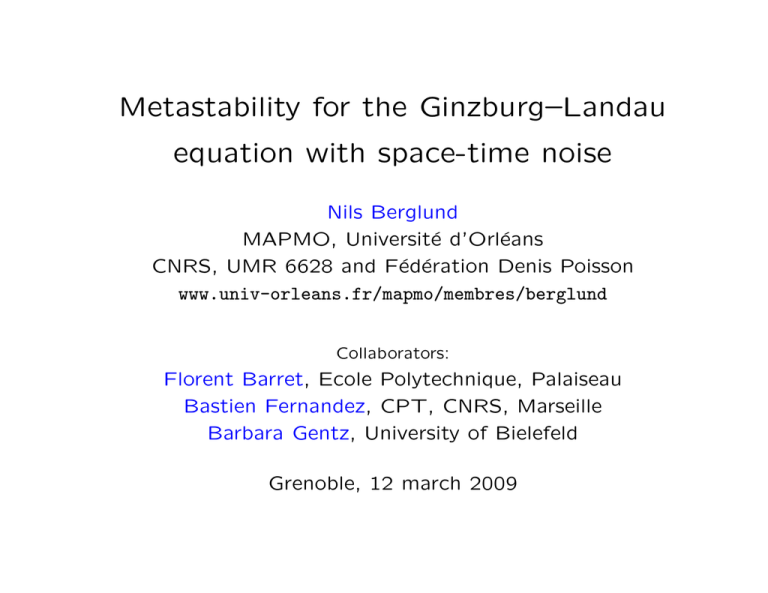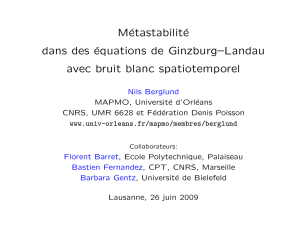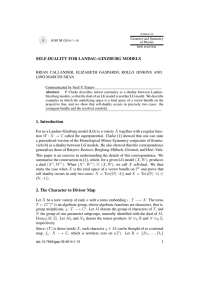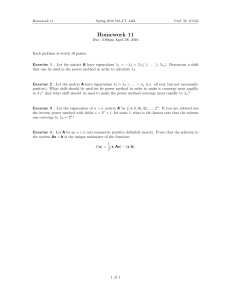Metastability for the Ginzburg–Landau equation with space-time noise
advertisement

Metastability for the Ginzburg–Landau
equation with space-time noise
Nils Berglund
MAPMO, Université d’Orléans
CNRS, UMR 6628 and Fédération Denis Poisson
www.univ-orleans.fr/mapmo/membres/berglund
Collaborators:
Florent Barret, Ecole Polytechnique, Palaiseau
Bastien Fernandez, CPT, CNRS, Marseille
Barbara Gentz, University of Bielefeld
Grenoble, 12 march 2009
Ginzburg–Landau equation
∂tu(x, t) = ∂xxu(x, t) + u(x, t) − u(x, t)3
x ∈ [0, L], u(x, t) ∈ R represents e.g. magnetisation
• Periodic b.c.
• Neumann b.c. ∂xu(0, t) = ∂xu(L, t) = 0
1
Ginzburg–Landau equation
∂tu(x, t) = ∂xxu(x, t) + u(x, t) − u(x, t)3 + noise
x ∈ [0, L], u(x, t) ∈ R represents e.g. magnetisation
• Periodic b.c.
• Neumann b.c. ∂xu(0, t) = ∂xu(L, t) = 0
Noise: weak, white in space and time
1-a
Ginzburg–Landau equation
∂tu(x, t) = ∂xxu(x, t) + u(x, t) − u(x, t)3 + noise
x ∈ [0, L], u(x, t) ∈ R represents e.g. magnetisation
• Periodic b.c.
• Neumann b.c. ∂xu(0, t) = ∂xu(L, t) = 0
Noise: weak, white in space and time
Deterministic system is gradient
∂V
3
[u(·, t)]
∂tu(x, t) = ∂xxu(x, t) + u(x, t) − u(x, t) = −
∂δ
x
Z L
1 0
1
1
2
2
V [u] =
u (x) − u(x) + u(x)4 dx
2
4
0 2
1-b
Stationary solutions
u00(x) = −u(x) + u(x)3 = −
d
dx
"
#
2
Stationary solutions
u00(x) = −u(x) + u(x)3 = −
d
dx
"
#
• u±(x) ≡ ±1: global minima of V , stable
• u0(x) ≡ 0: unstable
• Periodic b.c:
L > 2πk,
q for k = 1, 2, . . . , if √
kx
2m
√
+ ϕ, m
4k m + 1 K(m) = L
uk,ϕ(x) = m+1 sn
m+1
• Neumann b.c:
q for k =
1, 2, . . . , if L > πk,
√
kx
2m
√
+ K(m), m
2k m + 1 K(m) = L
uk,±(x) = ± m+1 sn
m+1
2-a
Stationary solutions
u00(x) = −u(x) + u(x)3 = −
d
dx
"
#
• u±(x) ≡ ±1: global minima of V , stable
• u0(x) ≡ 0: unstable
• Periodic b.c:
L > 2πk,
q for k = 1, 2, . . . , if √
kx
2m
√
+ ϕ, m
4k m + 1 K(m) = L
uk,ϕ(x) = m+1 sn
m+1
• Neumann b.c:
q for k =
1, 2, . . . , if L > πk,
√
kx
2m
√
+ K(m), m
2k m + 1 K(m) = L
uk,±(x) = ± m+1 sn
m+1
0
π
2π
3π
L
u0
u4,±
u3,±
u2,±
u1,±
2-b
Stability of stationary solutions
2
d
Linearisation at u(x): ∂tϕ = A[u]ϕ, A[u] = dx2 + 1 − 3u(x)2
3
Stability of stationary solutions
2
d
Linearisation at u(x): ∂tϕ = A[u]ϕ, A[u] = dx2 + 1 − 3u(x)2
Neumann b.c:
• u±(x) ≡ ±1: eigenvalues −(2 + (πk/L)2), k ∈ N
• u0(x) ≡ 0: eigenvalues 1 − (πk/L)2, k ∈ N
Number of positive eigenvalues:
0
π
1
2π
2
3π
L
3
4
u0
u4,±
1
2
3
u3,±
u2,±
u1,±
3-a
Stability of stationary solutions
2
d
Linearisation at u(x): ∂tϕ = A[u]ϕ, A[u] = dx2 + 1 − 3u(x)2
Neumann b.c:
• u±(x) ≡ ±1: eigenvalues −(2 + (πk/L)2), k ∈ N
• u0(x) ≡ 0: eigenvalues 1 − (πk/L)2, k ∈ N
Number of positive eigenvalues:
0
π
1
2π
2
3π
L
3
4
u0
u4,±
1
2
3
u3,±
u2,±
u1,±
Periodic b.c:
• eigenvalues at u0 are doubly degenerate
• one eigenvalue at uk,ϕ is always zero
3-b
Ginzburg–Landau equation with noise
∂tu(x, t) = ∂xx
u(x, t) + u(x, t) − u(x, t)3
√
+ 2ε ξ(x, t)
4
Ginzburg–Landau equation with noise
∂tu(x, t) = ∂xx
u(x, t) + u(x, t) − u(x, t)3
√
+ 2ε ξ(x, t)
Definition of space–time white noise ξ(x, t):
1. By taking derivative of Brownian sheet
2. By adding independent Brownian motions to each Fourier mode
4-a
Ginzburg–Landau equation with noise
∂tu(x, t) = ∂xx
u(x, t) + u(x, t) − u(x, t)3
√
+ 2ε ξ(x, t)
Definition of space–time white noise ξ(x, t):
1. By taking derivative of Brownian sheet
2. By adding independent Brownian motions to each Fourier mode
∞
X
Periodic b.c: u(x, t) = √1
L
yk (t) e2π i kx/L
k=−∞
X
√
1
(k)
yk1 yk2 yk3 + 2εẆt
ẏk = −λk yk −
L k +k +k =k
1
2
3
where λk = −1 + (2πk/L)2
4-b
Ginzburg–Landau equation with noise
∂tu(x, t) = ∂xx
u(x, t) + u(x, t) − u(x, t)3
√
+ 2ε ξ(x, t)
Definition of space–time white noise ξ(x, t):
1. By taking derivative of Brownian sheet
2. By adding independent Brownian motions to each Fourier mode
∞
X
Periodic b.c: u(x, t) = √1
L
yk (t) e2π i kx/L
k=−∞
X
√
1
(k)
yk1 yk2 yk3 + 2εẆt
ẏk = −λk yk −
L k +k +k =k
1
2
3
where λk = −1 + (2πk/L)2
Energy functional:
∞
X
1
1 X
2
λk |yk | +
yk1 yk2 yk3 yk4
V [{yk }] =
2 k=−∞
4L k +k +k +k =0
1
2
3
4
4-c
The question
How long does the system take to get from u−(x) ≡ −1
to (a neighbourhood of) u+(x) ≡ 1?
Metastability: Time of order econst /ε
(rate of order e−const /ε)
5
The question
How long does the system take to get from u−(x) ≡ −1
to (a neighbourhood of) u+(x) ≡ 1?
Metastability: Time of order econst /ε
(rate of order e−const /ε)
We seek constants ∆W (activation energy), Γ0 and α such that
the random transition time τ satisfies
i
−1
α
E[τ ] = Γ0 + O(ε ) e∆W/ε
h
5-a
Reversible diffusion
dxt = −∇V (xt) dt +
√
2ε dWt
. V : R d → R : potential, growing at infinity
. Wt: d-dim Brownian motion on (Ω, F , P)
Reversible w.r.t.
invariant measure:
e−V (x)/ε
µε(dx) =
dx
Zε
(detailed balance)
6
Reversible diffusion
dxt = −∇V (xt) dt +
√
2ε dWt
. V : R d → R : potential, growing at infinity
. Wt: d-dim Brownian motion on (Ω, F , P)
Reversible w.r.t.
invariant measure:
e−V (x)/ε
µε(dx) =
dx
Zε
(detailed balance)
z
x
y
τyx: first-hitting time of small ball Bε(y), starting in x
“Eyring–Kramers law” (Eyring 1935, Kramers 1940)
• Dim 1: E[τyx] ' √ 00 2π 00
e[V (z)−V (x)]/ε
V (x)|V
r (z)|
• Dim>
2: E[τyx] ' |λ 2π
1 (z)|
|det(∇2 V (z))| [V (z)−V (x)]/ε
e
det(∇2 V (x))
6-a
Towards a proof of Kramers’ law
• Large deviations (Wentzell & Freidlin 1969):
lim ε log(E[τyx]) = V (z) − V (x)
ε→0
= ∆W
• Analytic (Helffer, Sjöstrand 85, Miclo 95, Mathieu 95, Kolokoltsov 96,. . . ):
low-lying spectrum of generator
• Potential theory/variational (Bovier, Eckhoff, Gayrard, Klein 2004):
E[τyx] = |λ 2π
1 (z)|
r
h
i
|det(∇2 V (z))| [V (z)−V (x)]/ε
1/2
1/2
e
1 + O(ε
|log ε|
)
det(∇2 V (x))
and similar asymptotics for eigenvalues of generator
• Witten complex (Helffer, Klein, Nier 2004):
full asymptotic expansion of prefactor
• Distribution of τyx (Day 1983, Bovier et al 2005):
lim P
ε→0
o
x
x
τy > tE[τy ] = e−t
n
7
Formal computation for Ginzburg–Landau (R.S. Maier, D. Stein, 01)
Take e.g. Neumann b.c, L < π
Saddle state: u0 ≡ 0, V [u0] = 0
Activation energy: ∆W = V [u0] − V [u−] = L/4
8
Formal computation for Ginzburg–Landau (R.S. Maier, D. Stein, 01)
Take e.g. Neumann b.c, L < π
Saddle state: u0 ≡ 0, V [u0] = 0
Activation energy: ∆W = V [u0] − V [u−] = L/4
Eigenvalues at V [u−] ≡ −1: µk = 2 + (πk/L)2
Eigenvalues at V [u0] ≡ 0: λk = −1 + (πk/L)2
s
v
√
u Y
∞
|λ | u
µk
1
sinh( 2L)
Thus formally Γ0 ' 0 t
= 3/4
2π k=0 |λk |
sin L
2
π
8-a
Formal computation for Ginzburg–Landau (R.S. Maier, D. Stein, 01)
Take e.g. Neumann b.c, L < π
Saddle state: u0 ≡ 0, V [u0] = 0
Activation energy: ∆W = V [u0] − V [u−] = L/4
Eigenvalues at V [u−] ≡ −1: µk = 2 + (πk/L)2
Eigenvalues at V [u0] ≡ 0: λk = −1 + (πk/L)2
s
v
√
u Y
∞
|λ | u
µk
1
sinh( 2L)
Thus formally Γ0 ' 0 t
= 3/4
2π k=0 |λk |
sin L
2
π
Problems:
1. What happens when L → π−? (bifurcation)
2. Is the formal computation correct in infinite dimension?
8-b
Potential theory
Consider first Brownian motion Wtx = x + Wt
x = inf{t > 0 : W x ∈ A}, A ⊂ R d
Let τA
t
9
Potential theory
Consider first Brownian motion Wtx = x + Wt
x = inf{t > 0 : W x ∈ A}, A ⊂ R d
Let τA
t
x ] satisfies
Fact 1: wA(x) = E[τA
∆wA(x) = 1
wA(x) = 0
GAc (x, y) Green’s function ⇒ wA(x) =
x ∈ Ac
x∈A
Z
Ac
GAc (x, y) dy
9-a
Potential theory
Consider first Brownian motion Wtx = x + Wt
x = inf{t > 0 : W x ∈ A}, A ⊂ R d
Let τA
t
x ] satisfies
Fact 1: wA(x) = E[τA
x ∈ Ac
∆wA(x) = 1
x∈A
wA(x) = 0
GAc (x, y) Green’s function ⇒ wA(x) =
y
Z
Ac
GAc (x, y) dy
A
9-b
Potential theory
x < τ x ] satisfies
Fact 2: hA,B (x) = P[τA
B
∆hA,B (x) = 0
⇒ hA,B (x) =
Z
∂A
x ∈ (A ∪ B)c
hA,B (x) = 1
x∈A
hA,B (x) = 0
x∈B
GB c (x, y) ρA,B (dy)
10
Potential theory
x < τ x ] satisfies
Fact 2: hA,B (x) = P[τA
B
x ∈ (A ∪ B)c
∆hA,B (x) = 0
⇒ hA,B (x) =
Z
∂A
hA,B (x) = 1
x∈A
hA,B (x) = 0
x∈B
GB c (x, y) ρA,B (dy)
ρA,B : “surface charge density” on ∂A
−
−
−
−
−
+ + ++
+
+
+ A
+
+
+ ++
+
−
− −−
−
−
−
B
−
−
−
− − −−
1V
10-a
Potential theory
Capacity: capA(B) =
Z
∂A
ρA,B (dy)
11
Potential theory
Capacity: capA(B) =
Z
∂A
ρA,B (dy)
Key observation: let C = Bε(x), then (using G(y, z) = G(z, y))
Z
ZAc
Ac
hC,A(y) dy =
hC,A(y) dy =
Z
Z
ZAc ∂C
∂C
GAc (y, z)ρC,A(dz) dy
wA(z)ρC,A(dz) ' wA(x) capC (A)
11-a
Potential theory
Capacity: capA(B) =
Z
∂A
ρA,B (dy)
Key observation: let C = Bε(x), then (using G(y, z) = G(z, y))
Z
ZAc
Ac
hC,A(y) dy =
hC,A(y) dy =
Z
Z
ZAc ∂C
∂C
GAc (y, z)ρC,A(dz) dy
wA(z)ρC,A(dz) ' wA(x) capC (A)
Z
⇒
x ] = w (x) '
E[τA
A
Ac
hBε(x),A(y) dy
capBε(x)(A)
11-b
Potential theory
Capacity: capA(B) =
Z
∂A
ρA,B (dy)
Key observation: let C = Bε(x), then (using G(y, z) = G(z, y))
Z
ZAc
Ac
hC,A(y) dy =
hC,A(y) dy =
Z
Z
ZAc ∂C
∂C
GAc (y, z)ρC,A(dz) dy
wA(z)ρC,A(dz) ' wA(x) capC (A)
Z
⇒
x ] = w (x) '
E[τA
A
Ac
hBε(x),A(y) dy
capBε(x)(A)
Variational representation: Dirichlet form
capA(B) =
Z
(A∪B)c
k∇hA,B (x)k2 dx =
inf
Z
h∈HA,B (A∪B)c
k∇h(x)k2 dx
(HA,B : set of sufficiently smooth functions satisfying b.c.)
11-c
Potential theory
General case: dxt = −∇V (xt) dt +
√
2ε dWt
Generator: ∆ 7→ ε∆ − ∇V · ∇
Then
Z
x ] = w (x) '
E[τA
A
where
capA(B) = ε
inf
Z
h∈HA,B (A∪B)c
Ac
hBε(x),A(y) e−V (y)/ε dy
capBε(x)(A)
k∇h(x)k2 e−V (x)/ε dx
12
Potential theory
General case: dxt = −∇V (xt) dt +
√
2ε dWt
Generator: ∆ 7→ ε∆ − ∇V · ∇
Then
Z
x ] = w (x) '
E[τA
A
where
capA(B) = ε
inf
Z
h∈HA,B (A∪B)c
Ac
hBε(x),A(y) e−V (y)/ε dy
capBε(x)(A)
k∇h(x)k2 e−V (x)/ε dx
Rough a priori bounds on h show that if x potential minimum,
Z
(2πε)d/2 e−V (x)/ε
−V
(y)/ε
hBε(x),A(y) e
dy ' q
c
A
det(∇2V (x))
12-a
Estimation of capacity
Neumann b.c.
Truncated energy functional: retain only modes with k 6 d
d
1 2
1 X
V [{yk }] = − y0 + u1(y1) +
λk |yk |2 + . . .
2
2 k=2
2 + 3 y4
u1(y1) = 1
λ
y
1
1
2
8L 1
13
Estimation of capacity
Neumann b.c.
Truncated energy functional: retain only modes with k 6 d
d
1 2
1 X
V [{yk }] = − y0 + u1(y1) +
λk |yk |2 + . . .
2
2 k=2
2 + 3 y4
u1(y1) = 1
λ
y
1
1
2
8L 1
Theorem: For all L < π,
Z ∞
e−u1(y1)/ε dy1 Y
d u
i
u 2πε h
−∞
t
√
capBε(u−)(Bε(u+)) = ε
1 + R(ε)
λj
2πε
j=2
v
where R(ε) = O((ε|log ε|)1/4) is uniform in d.
13-a
Sketch of proof
Upper bound:
cap = inf Φ(h) 6 Φ(h+)
Φ(h) = ε
h
q
Let δ =
Z
k∇h(y)k2 e−V (y)/ε dy
cε|log ε|, choose
h+(y) =
1
f (y0)
0
for
for
for
y0 < −δ
−δ < y0 < δ
y0 > δ
where εf 00(y0) + ∂y0 V (y0, 0)f 0(y0) = 0 with b.c. f (±δ) = 0, 1
14
Sketch of proof
Upper bound:
cap = inf Φ(h) 6 Φ(h+)
Φ(h) = ε
h
q
Let δ =
Z
k∇h(y)k2 e−V (y)/ε dy
cε|log ε|, choose
h+(y) =
1
f (y0)
0
for
for
for
y0 < −δ
−δ < y0 < δ
y0 > δ
where εf 00(y0) + ∂y0 V (y0, 0)f 0(y0) = 0 with b.c. f (±δ) = 0, 1
Lower bound:
Bound Dirichlet Φ form below by restricting domain, taking only
1st component of gradient and use for b.c. a priori bound on h
14-a
Applications
Neumann b.c., L < π:
Γ0 =
1
23/4 π
r
√
sinh( 2L)
sin L
15
Applications
Neumann b.c., L < π:
Γ0 =
r
1
23/4 π
√
r
sinh( 2L)
λ1
√
√ λ1
Ψ
+
sin L
λ1 + 3ε/4L
3ε/4L
where λ1 = −1 + (π/L)2 and
r
Ψ+(α) =
2
α(1+α) α2 /16
α
e
K
1/4
8π
16
15-a
Applications
Neumann b.c., L < π:
Γ0 =
r
1
23/4 π
√
r
sinh( 2L)
λ1
√
√ λ1
Ψ
+
sin L
λ1 + 3ε/4L
3ε/4L
where λ1 = −1 + (π/L)2 and
r
Ψ+(α) =
2
α(1+α) α2 /16
α
e
K
1/4
8π
16
In particular,
q
√
Γ(1/4)
−1/4
lim Γ0 =
sinh(
2π)ε
L→π−
2(3π 7)1/4
15-b
Applications
Neumann b.c., L < π:
Γ0 =
r
1
23/4 π
√
r
sinh( 2L)
λ1
√
√ λ1
Ψ
+
sin L
λ1 + 3ε/4L
3ε/4L
where λ1 = −1 + (π/L)2 and
r
Ψ+(α) =
2
α(1+α) α2 /16
α
e
K
1/4
8π
16
In particular,
q
√
Γ(1/4)
−1/4
lim Γ0 =
sinh(
2π)ε
L→π−
2(3π 7)1/4
12
11
Γ0
ε = 0.0003
10
9
8
ε = 0.001
7
Similar expression for L > π
6
(product
4
of
eigenvalues
computed
5
using
path-integral techniques, cf. Maier and Stein)
ε = 0.003
ε = 0.01
3
2
L
π
1
0
0.3 0.4 0.5 0.6 0.7 0.8 0.9 1.0 1.1 1.2 1.3 1.4 1.5 1.6 1.7
15-c
Applications
Periodic b.c., L < 2π:
√
λ1
λ1
1 sinh(L/ 2)
f
√
√
Γ0 = 2π
Ψ
sin(L/2) λ1 + 3ε/4L +
3ε/4L
f
where λ1 = −1 + (2π/L)2, some bounded function Ψ
+
Similar expression for L > 2π
√
sinh( 2π) −1/2
√
lim Γ0 =
ε
L→2π−
3π
16
References
• R. S. Maier and D. L. Stein, Droplet nucleation and domain wall motion in
a bounded interval, Phys. Rev. Lett. 87, 270601-1 (2001)
• Anton Bovier, Michael Eckhoff, Véronique Gayrard and Markus Klein, Metastability in reversible diffusion processes I: Sharp asymptotics for capacities and
exit times, J. Eur. Math. Soc. 6, 399–424 (2004)
• N. B. and Barbara Gentz, The Eyring–Kramers law for potentials with nonquadratic saddles, arXiv/0807.1681 (2008)
• N. B. and Barbara Gentz, Anomalous behavior of the Kramers rate at bifurcations in classical field theories, J. Phys. A: Math. Theor. 42, 052001
(2009)
• Florent Barret, N. B. and Barbara Gentz, in preparation
17







